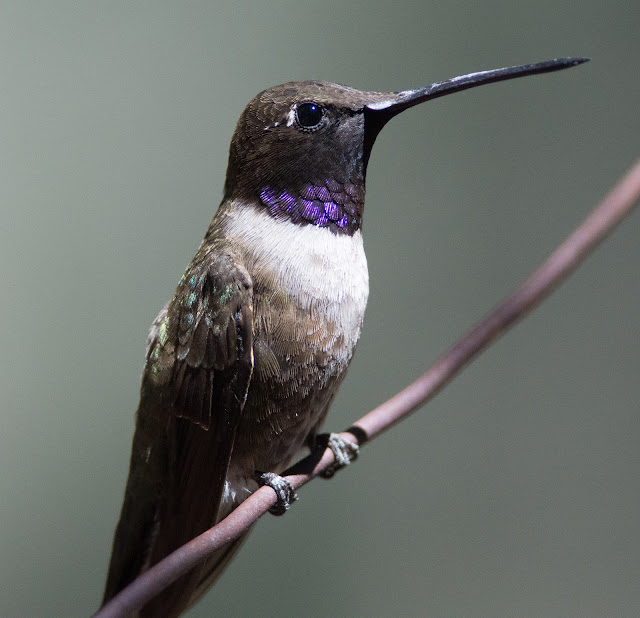Finally tired of the summer heat in the desert around the Phoenix area and wanted to go birding. Had a couple of options: head to Glendale Recharge Ponds to see a couple of rarities or head to the Pinals and look for migrants. Glendale, with no trees and no shade and temps hovering around 110° F, or the Pinals with lots of trees and shade and temps hovering around 72° F near the top? As much as I wanted to add a couple birds to my Maricopa list (but not life birds), the cooler temps of the Pinals won this battle. The Pinal Mountains is a fairly small mountain range south of Globe, AZ and at the highest point, Pinal Peak has an elevation of 7848 feet, so they are not huge by any standards, but they are much cooler than the surrounding desert and are considered to be part of the Arizona Sky Islands.
August tends to be a great time to visit as many migrants, including warblers, pass through here to fuel up on their trek south into Mexico and points beyond. In some cases, it brings juvenile birds of some species that can be difficult to identify at times, but very often it also brings in some strikingly stunning adults as well, still dressed in their breeding plumage. I found at least 6 species of warblers on this day and probably could have found more had I spent more time. Maybe a trip involving an overnight camp out, might be something to plan for the future. I know of a special place where there is most generally a small spring of water that rises above the ground and trickles down a short distance before disappearing back into the sandy stream bed. That bit of water is a mecca for many of these birds to drop in for a drink and a quick bath. My list of warblers for this awesome 6 hours included: Nashville, Wilson's, Orange-crowned, Hermit, Black-throated Gray, and one of Arizona's favorites, the Painted Redstart.
Hermit Warbler
Nashville Warbler
Nashville Warbler
Orange-crowned Warbler
Orange-crowned Warbler
Painted Redstart
Wilson's Warbler
Of course, warblers were not the only migrants to be found, but they are some of the most interesting and since most warblers are prone to be fast movers gleaning insects from plants, they are almost always a challenge to photograph. Not to be outdone by the warblers the family of hummingbirds was right up there with 6 species as well. Getting 6 species of hummingbirds in one area this close to the Phoenix metro area is rather special. Of course, there are many spots in southeastern Arizona that can double those numbers, but coming up with 6, is still pretty special this far north; Anna's, Black-chinned, Broad-tailed, Rufous, Calliope, and Magnificent were the 6 species. Part of the success for this, is the fact that one cabin owner at the tops of Pinal Peak has 5 hummingbird feeders out and many of these birds are fueling up and taking advantage of this on their southbound migration route.
Black-chinned Hummingbird
Broad-tailed Hummingbird - Female
Broad-tailed Hummingbird - Male
Magnificent Hummingbird
Rufous Hummingbird
Migrating Western Tanagers were thick and covered a large area of the mountains. This photo is definitely not the brilliantly colored male that most people go gaga over, but I have to admit, that this happens to be one of the most stunning female Western Tanagers that I have seen in a long time.
Western Tanager
Yellow-eyed Juncos must have had a banner year for breeding as they were quite numerous at almost all elevations. The Pinals are the northern most point in this bird's range. Will they eventually expand further north? Who knows, but one was located in Coconino County near Flagstaff a year ago.
Yellow-eyed Junco
Yellow-eyed Junco
And how can one ignore a bathing Mountain Chickadee or a foraging Brown Creeper, two of my favorite mountain dwelling birds?
Mountain Chickadee
Moluntain Chickadee
Brown Creeper
Brown Creeper - Note that thin bill which is designed for probing into cracks and crevices in the bark of trees for insects, grubs, and insect eggs.
One more item to mention, was that I found my first bear track. I did not know it was there, but a vehicle coming down from the mountain stopped and pointed it out to me in the mud on the side of the road. It was right above me and my warbler spot where I was watching warblers. Next time, I need to place an object next to it, to give an indication of its size. This track was about 7 or 8 inches in length. Maybe someday I will finally see an actual bear at a distance!
I definitely do not regret giving up the 2 rarities at Glendale for this turned out to be a great outing!





















Beautiful shots. It's so hard to get a Black-Chinned with its collar showing like that.
ReplyDeleteFantastic crushes Gordon!
ReplyDeleteGood choice, Gordon. Fab photos, too.
ReplyDelete